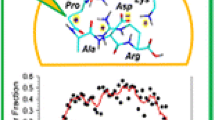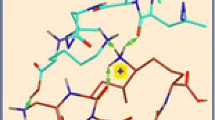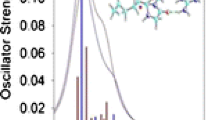Abstract
Gas-phase conformations and electron transfer dissociations of pentapeptide ions containing the photo-Leu residue (L*) were studied. Exhaustive conformational search including molecular dynamics force-field, semi-empirical, ab initio, and density functional theory calculations established that the photo-Leu residue did not alter the gas-phase conformations of (GL*GGK + 2H)2+ and (GL*GGK-NH2 + H)+ ions, which showed the same conformer energy ranking as the unmodified Leu-containing ions. This finding is significant in that it simplifies conformational analysis of photo-labeled peptide ions. Electron transfer dissociation mass spectra of (GL*GGK + 2H)2+, (GL*GGK-NH2 + 2H)2+,(GL*GGKK + 2H)2+, (GL*GLK + 2H)2+, and (GL*LGK + 2H)2+ showed 16 %–21 % fragment ions originating by radical rearrangements and cleavages in the diazirine ring. These side-chain dissociations resulted in eliminations of N2H3, N2H4, [N2H5], and [NH4O] neutral fragments and were particularly abundant in long-lived charge-reduced cation-radicals. Deuterium labeling established that the neutral hydrazine molecules mainly contained two exchangeable and two nonexchangeable hydrogen atoms from the peptide and underwent further H/D exchange in an ion–molecule complex. Electron structure calculations on the charge-reduced ions indicated that the unpaired electron was delocalized between the diazirine and amide π* electronic systems in the low electronic states of the cation-radicals. The diazirine moiety in GL*GGK-NH2was calculated to have an intrinsic electron affinity of 1.5 eV, which was further increased by the Coulomb effect of the peptide positive charge. Mechanisms are proposed for the unusual elimination of hydrazine from the photo-labeled peptide ions.

ᅟ





Similar content being viewed by others
References
Li, X., Cournoyer, J.J., Lin, C., O’Connor, P.B.: The effect of fixed charge modifications on electron capture dissociation. J. Am. Soc. Mass Spectrom. 19, 1514–1526 (2008)
Chamot-Rooke, J., van der Rest, G., Dalleu, A., Bay, S., Lemoine, J.: The combination of electron capture dissociation and fixed charge derivatization increases sequence coverage for O-glycosylated and O-phosphorylated peptides. J. Am. Soc. Mass Spectrom. 18, 1405–1413 (2007)
Chung, T.W., Tureček, F.: Selecting fixed-charge groups for electron-based peptide dissociations. A computational study of pyridinium tags. Int. J. Mass Spectrom. 276, 127–135 (2008)
Chung, T.W., Tureček, F.: Electron transfer to charge-tagged peptide ions. A computational analysis of electronic states. Eur. J. Mass Spectrom. 14, 367–378 (2008)
Chung, T.W., Moss, C.L., Zimnicka, M., Johnson, R.S., Moritz, R.L., Tureček, F.: Electron capture and transfer of peptides tagged with tunable fixed-charge groups. Structures and dissociation energies. J. Am. Soc. Mass Spectrom. 22, 13–30 (2011)
Zimnicka, M., Moss, C.L., Chung, T.W., Hui, R., Tureček, F.: Tunable charge tags for electron-based methods of peptide sequencing. design and applications. J. Am. Soc. Mass Spectrom 23, 608–620 (2012)
Ross, P.L., Huang, Y.L.N., Marchese, J.N., Williamson, B., Parker, K., Hattan, S., Khainovski, N., Pillai, S., Dey, S., Daniels, S., Purkayastha, S., Juhasz, P., Martin, S., Bartlet-Jones, M., He, F., Jacobson, A., Pappin, D.J.: Multiplexed protein quantitation in Saccharomyces cerevisiae using amine-reactive isobaric tagging reagents. Mol. Cell. Proteomics 3, 1154–1169 (2004)
Han, H., Pappin, D.J., Ross, P.L., McLuckey, S.A.: Electron transfer dissociation of iTRAQ labeled peptide ions. J. Proteome Res. 7, 3643–3648 (2008)
Hennrich, M.L., Boersema, P.J., van den Toorn, H., Mischerikow, N., Heck, A.J.R., Mohammed, S.: Effect of chemical modifications on peptide fragmentation behavior upon electron transfer induced dissociation. Anal. Chem. 81, 7814–7822 (2009)
Jensen, C.S., Holm, A.I.S., Zettergren, H., Overgaard, J.B., Hvelplund, P., Nielsen, S.B.: On the charge partitioning between c and z fragments formed after electron-capture induced dissociation of charge-tagged lys-lys and ala-lys dipeptide dications. J. Am. Soc. Mass Spectrom. 20, 1881–1889 (2009)
Belyayev, M.A., Cournoyer, J.J., Lin, C., O’Connor, P.B.: The effect of radical trap moieties on electron capture dissociation spectra of substance P. J. Am. Soc. Mass Spectrom. 17, 1428–1436 (2006)
Tureček, F.: Electron predators are hydrogen atom traps. Effects of aryl groups on N–Cα bond dissociations of peptide radicals. J. Mass Spectrom. 45, 1280–1290 (2010)
Jones, J.W., Sasaki, T., Goodlett, D.R., Tureček, F.: Electron capture in spin-trap capped peptides. An experimental example of ergodic dissociation in peptide cation-radicals. J. Am. Soc. Mass Spectrom. 18, 432–444 (2007)
Sohn, C.H., Chung, C.K., Yin, S., Ramachandran, P., Loo, J.A., Beauchamp, J.L.: Probing the mechanism of electron capture and electron transfer dissociation using tags with variable electron affinity. J. Am. Chem. Soc. 131, 5444–5459 (2009)
Ben Hamidane, H., Vorobyev, A., Larregola, M., Lukaszuk, A., Tourwe, D., Lavielle, S., Karoyan, P., Tsybin, Y.O.: Radical stability directs electron capture and transfer dissociation of β-amino acids in peptides. Chem. Eur. J. 16, 4612–4622 (2010)
Sargaeva, N.P., Lin, C., O’Connor, P.B.: Unusual fragmentation of β-linked peptides by ExD tandem mass spectrometry. J. Am. Soc. Mass Spectrom. 22, 480–491 (2011)
Kjeldsen, F., Zubarev, R.A.: Effects of peptide backbone amide-to-ester bond substitution on the cleavage frequency in electron capture dissociation and collision-activated dissociation. J. Am. Soc. Mass Spectrom. 22, 1441–1452 (2011)
Hansen, T.A., Jung, H.R., Kjeldsen, F.: Electron transfer dissociation reveals changes in the cleavage frequencies of backbone bonds distant to amide-to-ester substitutions in polypeptides. J. Am. Soc. Mass Spectrom. 22, 1953–1957 (2011)
Zimnicka, M., Chung, T.W., Moss, C.L., Tureček, F.: Perturbing peptide cation-radical electronic states by thioxoamide groups: Formation, dissociations and energetics of thioxopeptide cation-radicals. J. Phys. Chem. A 117, 1265–1280 (2013)
Kumar, A.B., Anderson, J.M., Manetsch, R.: Design, synthesis, and photoactivation studies of fluorous photolabels. Org. Biomol. Chem. 9, 6284–6292 (2011)
Hashimoto, M., Hatanaka, Y.: Recent progress in diazirine-based photoaffinity labeling. Eur. J. Org. Chem. 2513–2523. doi:10.1002/ejoc.200701069 (2008)
Das, J.: Aliphatic diazirines as photoaffinity probes for proteins: Recent developments. Chem. Rev. 111, 4405–4417 (2011)
Dubinsky, L., Bastiaan, P., Krom, B.P., Meijler, M.M.: Diazirine based photoaffinity labeling. Bioorg. Med. Chem. 20, 554–570 (2012)
Liu, M.T.H.: Chemistry of Diazirines; Vol. I and II. CRC Press, Boca Raton (1987)
Korneev, S.M.: Valence Isomerization between diazo compounds and diazirines. Eur. J. Org. Chem. 6153–6175. doi:10.1002/ejoc.201100224 (2011)
Barton, D.H.R., Jaszberenyi, J.C., Theodorakis, E.A., Reibenspies, J.H.: The invention of radical reactions. 30. Diazirines as carbon radical traps. Mechanistic aspects and synthetic applications of a novel and efficient amination process. J. Am. Chem. Soc. 115, 8050–8059 (1993)
Moss, R.A., Xue, S., Liu, W.: Mechanistic origins of acyloxydiazirines. J. Am. Chem. Soc. 116, 10821–10822 (1994)
Moss, C.L., Chamot-Rooke, J., Brown, J., Campuzano, I., Richardson, K., Williams, J., Bush, M., Bythell, B., Paizs, B., Turecek, F.: Assigning structures to gas-phase peptide cations and cation-radicals. An infrared multiphoton dissociation, ion mobility, electron transfer and computational study of a histidine peptide ion. J. Phys. Chem. B 106, 3445–3456 (2012)
Syka, J.E.P., Coon, J.J., Schroeder, M.J., Shabanowitz, J., Hunt, D.F.: Peptide and protein sequence analysis by electron transfer dissociation mass spectrometry. Proc. Natl. Acad. Sci. U. S. A. 101, 9528–9533 (2004)
Janz, J.M., Ren, Y., Looby, R., Kazmi, M.A., Sachdev, P., Grunbeck, A., Haggis, L., Chinnapen, D., Lin, A.Y., Seibert, C., McMurry, T., Carlson, K.E., Muir, T.W., Hunt, S., Sakmar, T.P.: Direct interaction between an allosteric agonist pepducin and the chemokine receptor CXCR4. J. Am. Chem. Soc. 133, 15878–15881 (2011)
Coste, J., LeNguyen, D., Castro, B.: PyBOP@: A new peptide coupling reagent devoid of toxic by-product. Tetrahedron Lett. 31, 205–208 (1990)
Compton, P.D., Strukl, J.V., Bai, D.L., Shabanowitz, J., Hunt, D.F.: Optimization of electron transfer dissociation via informed selection of reagents and operating parameters. Anal. Chem. 84, 1781–1785 (2012)
Moss, C.L., Chung, T.W., Wyer, J.A., Nielsen, S.B., Hvelplund, P., Tureček, F.: Dipole-guided electron capture causes abnormal dissociations of phosphorylated pentapeptides. J. Am. Soc. Mass Spectrom. 22, 731–751 (2011)
Stewart, J.J.P.: Optimization of parameters for semiempirical methods. V. Modification of NDDO approximations and application to 70 elements. J. Mol. Model. 13, 1173–1213 (2007)
Frisch, M.J., Trucks, G.W., Schlegel, H.B., Scuseria, G.E., Robb, M.A., Cheeseman, J.R., Scalmani, G., Barone, V., Mennucci, B., Petersson, G.A., Nakatsuji, H., Caricato, M., Li, X., Hratchian, H.P., Izmaylov, A.F., Bloino, J., Zheng, G., Sonnenberg, J.L., Hada, M., Ehara, M., Toyota, K., Fukuda, R., Hasegawa, J., Ishida, M., Nakajima, T., Honda, Y., Kitao, O., Nakai, H., Vreven, T., Montgomery Jr., J.A., Peralta, J.E., Ogliaro, F., Bearpark, M., Heyd, J.J., Brothers, E., Kudin, K.N., Staroverov, V.N., Kobayashi, R., Normand, J., Raghavachari, K., Rendell, A., Burant, J.C., Iyengar, S.S., Tomasi, J., Cossi, M., Rega, N., Millam, J.M., Klene, M., Knox, J.E., Cross, J.B., Bakken, V., Adamo, C., Jaramillo, J., Gomperts, R., Stratmann, R.E., Yazyev, O., Austin, A.J., Cammi, R., Pomelli, C., Ochterski, J.W., Martin, R.L., Morokuma, K., Zakrzewski, V.G., Voth, G.A., Salvador, P., Dannenberg, J.J., Dapprich, S., Daniels, A.D., Farkas, O., Foresman, J.B., Ortiz, J.V., Cioslowski, J., Fox, D.J.: Gaussian 09, Revision A.02. Gaussian, Inc, Wallingford (2009)
Becke, A.D.: New mixing of Hartree-Fock and local density-functional theories. J. Chem. Phys. 98, 1372–1377 (1993)
Becke, A.D.: Density functional thermochemistry. III. The role of exact exchange. J. Chem. Phys. 98, 5648–5652 (1993)
Zhao, Y., Truhlar, D.G.: The M06 suite of density functionals for main group thermochemistry, thermochemical kinetics, noncovalent interactions, excited states, and transition elements: Two new functionals and systematic testing of four M06-class functionals and 12 other functionals. Theor. Chem. Accounts 120, 215–241 (2008)
Møller, C., Plesset, M.S.: A note on an approximation treatment for many-electron systems. Phys. Rev. 46, 618–622 (1934)
Tureček, F., Wolken, J.K.: Dissociation energies and kinetics of aminopyrimidinium radicals by ab initio and density functional theory. J. Phys. Chem. A 103, 1905–1912 (1999)
Wolken, J.K., Tureček, F.: Heterocyclic radicals in the gas phase. Experimental and computational study of 3-hydroxypyridinium radicals and cations. J. Am. Chem. Soc. 121, 6010–6018 (1999)
Wolken, J.K., Tureček, F.: Modeling nucleobase radicals in the gas phase. Experimental and computational study of 2-hydroxypyridinium and 2-(1H)pyridone radicals. J. Phys. Chem. A 103, 6268–6281 (1999)
Furche, F., Ahlrichs, A.: Adiabatic time-dependent density functional methods for excited state properties. J. Chem. Phys. 117, 7433–7447 (2002)
Reed, A.E., Weinstock, R.B., Weinhold, F.: Natural population analysis. J. Chem. Phys. 83, 735–746 (1985)
Liu, J., Liang, X., McLuckey, S.A.: On the value of knowing a z• ion for what it is. J. Proteome Res. 7, 130–137 (2008)
Sun, Q., Nelson, H., Stolz, B.M., Julian, R.R.: Side chain chemistry mediates backbone fragmentation in hydrogen deficient peptide radicals. J. Proteome Res. 8, 958–966 (2009)
Chung, T.W., Tureček, F.: Backbone and side-chain specific dissociations of z ions from non-tryptic peptides. J. Am. Soc. Mass Spectrom. 21, 1279–1295 (2010)
Ledvina, A.R., Chung, T.W., Hui, R., Coon, J.J., Turecek, F.: Cascade dissociations of peptide cation-radicals. Part 2. Infrared multiphoton dissociation and mechanistic studies of z-ions from pentapeptides. J. Am. Soc. Mass Spectrom. 23, 1351–1363 (2012)
Haag, N., Holm, A.I.S., Johansson, H.A.B., Zettergren, H., Schmidt, H.T., Nielsen, SB., Hvelplund, P., Cederquist, H.: Electron capture induced dissociation of doubly protonated pentapeptides: Dependence on molecular structure and charge separation. J. Chem. Phys. 134, 035102/1–035102/6 (2011)
Tureček, F.: The use of labeled compounds. In: Splitter, J.S., Turecek, F. (eds.) Applications of Mass Spectrometry to Organic Stereochemistry, Appendix 1. VCH Publishers, New York (1994)
NIST Standard Reference Database Number 69, available at: http://webbook.nist.gov/chemistry/. Accessed 24 Mar 2013
Hopkinson, A.C.: Radical cations of amino acids and peptides: Structures and stabilities. Mass Spectrom. Rev. 28, 655–671 (2009)
Yalcin, T., Khouw, C., Csizmadia, I.G., Peterson, M.R., Harrison, A.G.: Why are b ions stable species in peptide spectra? J. Am. Soc. Mass Spectrom. 6, 1165–1174 (1995)
Harrison, A.G.: The gas-phase basicities and proton affinities of amino acids and peptides. Mass Spectrom. Rev. 16, 201–217 (1997)
Elson, C.M., Liu, M.T.H., Mailer, C.E.S.R.: Studies of diazirine anion radicals. J. Chem. Soc. Chem. Commun. 504–506. doi:10.1039/C39860000504 (1986)
Yao, C., Turecek, F.: Hypervalent ammonium radicals. Competitive N–C and N–H bond dissociations in methylammonium and ethylammonium. Phys. Chem. Chem. Phys. 7, 912–920 (2005)
Holm, A.I.S., Larsen, M.K., Panja, S., Hvelplund, P., Nielsen, S.B., Leib, R.D., Donald, W.A., Williams, E.R., Hao, C., Tureček, F.: Electron capture, femtosecond electron transfer and theory: A study of noncovalent crown ether 1, n-diammonium alkane complexes. Int. J. Mass Spectrom. 276, 116–126 (2008)
Chung, T.W., Turecek, F.: Selecting fixed-charge groups for electron-based peptide dissociations. A computational study of pyridinium tags. Int. J. Mass Spectrom. 276, 127–135 (2008)
Neff, D., Sobczyk, M., Simons, J.: Through-space and through-bond electron transfer within positively charged peptides in the gas phase. Int. J. Mass Spectrom. 276, 91–101 (2008)
Acknowledgments
Financial support by a grant to F.T. from the National Science Foundation (CHE-1055132) is gratefully acknowledged. K.L. thanks the ARCS foundation for financial support. Instrumentation support for the low-resolution ETD mass spectra measurements was provided by the University of Washington Proteomics Resource (Dr. Priska von Haller). The authors thank Drs. Rob Moritz and Sarah Lee of the Seattle Institute for Systems Biology for providing access to the Thermo-Fisher Orbitrap Velos ETD instrument, and Dr. Jan Urban for advice with peptide syntheses.
Author information
Authors and Affiliations
Corresponding author
Electronic supplementary material
Below is the link to the electronic supplementary material.
ESM 1
(PDF 2987 kb)
Rights and permissions
About this article
Cite this article
Marek, A., Pepin, R., Peng, B. et al. Electron Transfer Dissociation of Photolabeled Peptides. Backbone Cleavages Compete with Diazirine Ring Rearrangements. J. Am. Soc. Mass Spectrom. 24, 1641–1653 (2013). https://doi.org/10.1007/s13361-013-0630-0
Received:
Revised:
Accepted:
Published:
Issue Date:
DOI: https://doi.org/10.1007/s13361-013-0630-0




